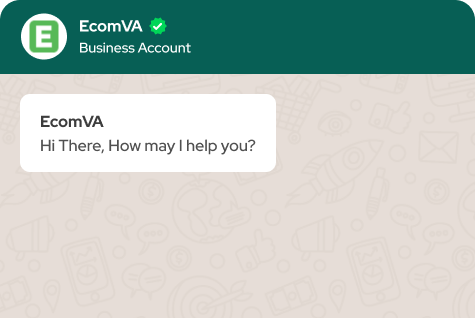How design part help for ecommerce business
An e-commerce website design should have the correct elements in the right place to engage visitors for longer. Designing an e-commerce store needs the precision and expertise of the designer to know your business to create the right e-commerce website that meets your brand value.
The design aspect plays a critical role in the success of an e-commerce business. A well-thought-out, user-friendly design can significantly impact the user experience, build trust, and drive conversions and sales.
Here’s how a good website design can help your e-commerce business:
User Experience (UX) Improvement
Creating an experience that satisfies your clients is the ultimate goal of a well-designed e-commerce website, not simply about looks.
Think of your website as a well-organized store:
- The navigation is evident and easy to use
- The products are categorized to keep things structured
- The checkout procedure is easy and quick, allowing customers to purchase without fuss.
- The smooth experience increases client satisfaction and encourages repeat business.
Branding and Identity
Beyond being aesthetically pleasing, your website’s design represents your brand. The typefaces, color palette, logo, and overall design should represent your brand’s personality. A virtual design assistant will maintain consistency throughout your website, helping improve your brand identity and establish your credibility with visitors.
Visiting a business with a continuously changing logo and design would be perplexing. This also holds true for your website. A consistent brand identity increases awareness and trust, giving your consumers a feeling of comfort and familiarity.
Visual Appeal
High-quality product photos serve as your online store’s equivalent of storefront displays. Grainy or blurry photographs give the wrong impression, whereas well-lit pictures highlight your product.
Click photos from various perspectives, up-close photos to accentuate specifics, and even lifestyle photos showing your items in action. Remember that aesthetics and practicality are what captivate people. Visually presenting your products draws customers in, tells a story, and raises the worth of what you have to offer.
Mobile Responsiveness
The days of desktop-only browsing are over. Savvy consumers today use their mobile devices for many purposes, including online shopping. If your website has a responsive design, it will adjust smoothly to various screen sizes, including those of computers, tablets, and smartphones.
Regardless of the device, everyone should have a seamless, easy-to-use buying experience with a mobile-friendly design. This will increase your reach and potential customer base. You can hire a design virtual assistant to create a responsive website.
Trust and Credibility
A professional website is a testament to your company’s authenticity. Consider it as a spotless, well-kept store; it exudes care and attention to detail, which in turn inspires confidence in the eyes of your customers.
On the other hand, a badly built website with old components or sluggish loading speeds can give the impression that it is unreliable. Putting money into a well-designed website is an investment in developing consumer trust, which is crucial for increasing sales and conversions.
Product Presentation
Design decisions significantly impact how buyers view your products. Having excellent photos is only the first step. Consider your product descriptions as little narratives that draw readers in and emphasize the features and advantages of your offerings. If you want to highlight real-world use cases, consider incorporating Zoom capabilities for precise specs, comprehensive product views, and even user-generated material like lifestyle images.
You can turn static objects on a screen into appealing answers to the demands and goals of your target audience by creating an engaging product presentation.
Call to Action (CTA) Optimization
A well-designed website should compel users to take action rather than merely display things. On your website, Calls To Action (CTAs) such as “Buy Now” buttons are the key players and converters. Their efficacy is greatly influenced by their design. A button’s well-written content, smart placement, and clear, contrasting colors all draw in customers and encourage them to click through.
Consider a store where the “Buy” buttons are hidden and dimly lit, making it possible for customers to miss them completely! In short, by optimizing your CTAs, you are directing clients toward completing their transactions within your online store. A graphic design virtual assistant can create captivating CTA elements to capture visitors’ attention.
Personalization and Recommendations
Imagine a store that greets you by name and suggests items based on your past purchases. This is the power of personalization in e-commerce. A well-designed e-commerce platform can utilize user data to provide personalized product recommendations, creating a more tailored shopping experience and potentially increasing average order value.
Loading Speed and Performance
The way a website is designed can greatly influence how quickly it loads. Slow loading times can be caused by large picture files, complicated layouts, and poorly optimized code. In today’s fast-paced environment, customers are impatient. A website that loads slowly will irritate users, and they will abandon their cart.
Making website speed optimization a top priority will guarantee a smooth browsing experience that keeps users interested and intent on completing a transaction. Moreover, it is also a major point that e-commerce SEO services focus on, as website loading speed will ultimately impact your rank on the SERP.
Security and Privacy Assurance
Security is crucial in the realm of online business. During the checkout process, customers entrust you with their financial and personal information. Design elements can communicate these security features and build trust. For example, showing SSL certificates and secure payment symbols visually reassures users that their data is safe. Trust badges from reputable security suppliers are another option.
If there was no security guard at a business with a locked door, would you feel safe leaving your possessions there? This also holds true for your website. Customers are given trust by security assurances in design, which motivates them to finish transactions without concern.
Easy Checkout Process
Checkout should be the final, frictionless hurdle before a customer completes their purchase. A well-designed checkout page assures a clean and straightforward layout, reduces the number of steps needed, and provides guest checkout alternatives for quicker transactions.
You can add progress indicators to let clients know how close they are to finishing the checkout process. You should also provide a variety of safe payment gateway choices for their convenience.
Feedback and Reviews Integration
Customer reviews and feedback are powerful tools for building trust and social proof. Design can facilitate the integration of these elements into your website. Imagine a store with no customer testimonials – how would you know if it’s trustworthy? By incorporating reviews and feedback strategically, you allow your customers to become advocates for your brand and provide valuable insights that can help you improve your products and services.
Customer reviews are excellent resources for establishing social proof and trust. Positive reviews from previous customers can significantly influence buying decisions for new customers.
Through the strategic integration of reviews and feedback, you enable your consumers to act as brand ambassadors and offer insightful input that can help you enhance your business.
Here are some common mistakes to avoid when designing a website:
1. Unclear Navigation and User Interface (UI):
- Complex Menus: Don’t overwhelm visitors with cluttered menus. Organize product categories logically and keep menus concise and easy to navigate.
- Inconsistent Layout: Maintain a consistent layout across your website. This includes using the same fonts, colour schemes, and button styles throughout the website to create a user-friendly and familiar experience.
- Hidden Search Bar: SEO virtual assistant will make the search bar easily accessible on every page. This allows customers to find specific products without navigating through categories.
2. Low-Quality Images and Product Descriptions:
- Grainy or Blurry Photos: Invest in high-quality product images that show your products from multiple angles and in clear detail. Blurry or pixelated photos can make your products appear cheap and unprofessional.
- Thin Descriptions: Go beyond basic product specifications. Write informative and engaging product descriptions that highlight features and benefits and address potential customer questions.
3. Ignoring Mobile Optimization:
- Non-Responsive Design: In today’s mobile-first world, ensure your website displays flawlessly on all devices, especially smartphones and tablets. A website that requires zooming or scrolling struggles to convert mobile viewers into buyers.
- Slow Loading Times: Optimize your website for speed. Slow loading times can frustrate mobile users with limited data plans and lead to cart abandonment.
4. Confusing Checkout Process:
- Hidden Costs: Be upfront about all costs associated with the purchase, including taxes and shipping fees. Don’t hit customers with surprise charges during checkout.
- Lengthy Multi-Step Checkout: Streamline your checkout process. Keep the number of steps to a minimum and avoid requiring unnecessary account creation for guest purchases.
- Unclear Security Measures: Display security badges and trust signals to assure customers that their financial information is protected during checkout.
5. Lack of Customer Support Information
- Missing Contact Details: Make it easy for customers to reach you. Clearly display your contact on your website, including your email address and phone number (if applicable).
- No FAQ Section: Include a Frequently Asked Questions (FAQ) section that addresses common customer inquiries about products, shipping, returns, and other relevant topics.
- Limited Help Options: Offer multiple ways for customers to get help, such as live chat functionalities or clear instructions for submitting support tickets.
End Note!
Remember that your website’s design should align with your target audience’s preferences and needs. Regularly updating and refining your design based on user feedback and industry trends will ensure that your e-commerce business remains competitive and continues to provide a positive customer experience.
Some unique elements in the design and ease of navigation in the website design will help you engage with the audience effectively. It is essential to meet the audience’s expectations and convince them to make the final decision effortlessly.





